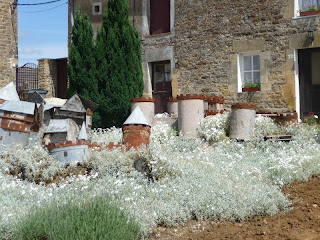The North West of Ardenne is an important border since the era of the Gauls. It was very strategic during an insecure and instable political era, hence today it is an important heritage of fortifications.
While N&H were traveling in Prague, my mom and I headed towards this region to explore Rocroi, a village fortified in the shape of a star.

The beautiful green campagne road passes farms with grazing cattle and forests and we were ooh-ing and aah-ing all the way. Unfortunately, as the road is one of the roads leading to Belgium (2.5km north of Rocroi), and going through the forest areas, there were many heavy trucks with wood on the road. But the beautiful surroundings made up for that.
Rocroi (Roche du Roy - or in English: Rock of the King, briefly renamed during the Revolution to Roc-Libre, Free Rock) played an important role in the history of France. King François I (the one who also built Chambord I wrote about, and many other places, and let Leonardo de Vinci came from Italy to live in Amboise) chose Rocroi as important (inaccessible) defense to protect the kingdom and instructed the fortification of the village. Later Vauban, famous designer of many fortifications in France, spent three years in Rocroi, and created a double line of protection, wanting to have 26 fortications (including some churches) along the border, of which Rocroi formed part. Today you can follow the different marked tourist routes to explore these fortifications (or what is left of some).
Considered as one of the ten biggest military victories in the history of France is the Battle of Rocroi, on 19 May 1643, during the Thirty Years War. Spain was very powerful during this period and occupied Belgium and the Netherlands at that stage. The Spanish commenced an attack on France and chose to go via Rocroy. After an intense battle at Rocroy, the Spanish had to retreat after a major loss. This was an important victory to Louis de Bourbon, future Prince of Condé, and one of a few major battefield defeats over Spain in more than a century, especially a defeat over one of their most famous units.
Even though Spain did manage to occupy Rocroi 10 years later in 1653, it was returned to France during the signing of the peace treaty, the Peace of the Pyrennees.
We didn't visit the Museum dedicated to this famous battle, but were walking through the village, disappointed that it seems a bit neglected and not much going on and not much information on display. There was a bitterly cold wind blowing and we haven't dressed warm enough for the day (despite being a beautiful region, they don't often have beautiful weather...) and were happy to find a restaurant where we could sit inside and enjoy a wonderful traditional French meal.
Above: the town square
Below: an old passage (you don't need a map for the village - impossible to get lost!)
The fortification (it was after lunch, fortunately the weather improved by then)
At 2pm, like in the rest of France, places opened after the long lunch break, and we could fetch some brochures on the region as we have decided we would like to see other places in the vicinity, but were a bit unprepared, as we didn't expect to spend such a short time in Rocroy. Escaping the cold by sitting in the car glancing through a handful of brochures and checking the distances on the GPS, we've settled for the Château de Montcornet.
Along the road (us still ooh-ing and aah-ing for the beautiful surroundings) we've passed people hiking, forests, more farms. It is just one of those regions where, if you have beautiful weather (which we had by then), you can have an awesome time.
The château de Montcornet is one of the biggest medieval fortifications in the Ardenne. At the end of the 10th-c the archbishops of Reims and the earls of Champagne wanted to secure this region against invasions from the Germanics.
The château changed hands over the centuries. In 1303 the then owners built a chapel next to the château, the chapelle Sainte Marie Madeleine (recently restored).
In 1446 the château was purchased by Antoine de Croy, a soldier and diplomat, who transformed the castle to suit artillery and iron balls. Other owners to follow were Charles de Gonzague, a descendant of Richelieu and other marquis and dukes. Today the castle hosts a museum, but unfortunately it was closed on the day that we have visited.
One can do an 1 hour walk around the castle - but considering the up and downhills it will comprise, we've used the excuse of not having enough time!
The village is beautiful, the wide clean tidy streets, neat stone houses, the gardeners were busy working the village gardens, you have a beautiful view from the castle. Worth a visit!
Above: an arty creation of the castle in a garden
Below: a pretty guest house
Above: the beautiful view from the castle
Below: on the way back we first tried a small road but after a few nerve wrecking moments we've decided to join the bigger road asap. At one stage I had to stop for road works and I've managed to capture the beautiful surroundings from the car!



















No comments:
Post a Comment